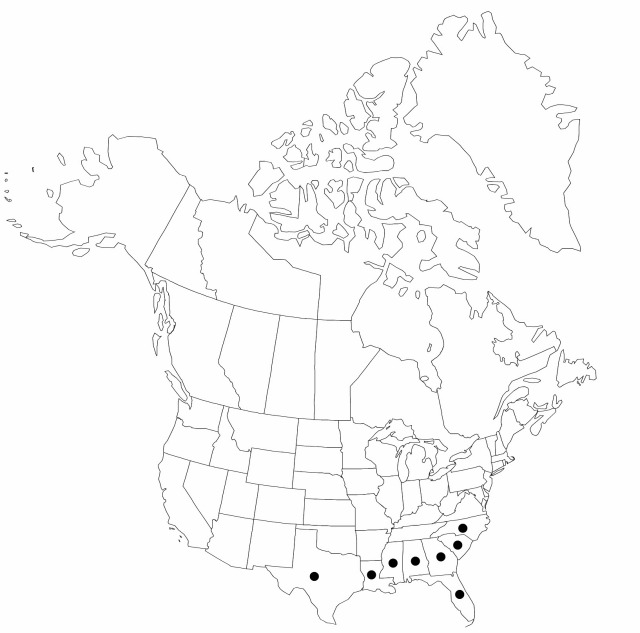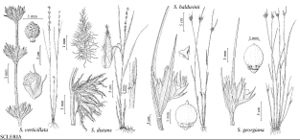Difference between revisions of "Scleria georgiana"
Brittonia 1: 243. 1934.
FNA>Volume Importer |
FNA>Volume Importer |
(No difference)
| |
Revision as of 19:08, 24 September 2019
Plants perennial; rhizomes horizontal, nodulose. Culms sometimes in tufts, erect, slender, 30–50 cm, wiry, glabrous, trigonous, base somewhat swollen, brown. Leaves: sheaths purplish, wingless, weakly ribbed, glabrous or minutely hirsute; contra-ligules absent; blades linear or filiform, shorter than culms, resembling them, strongly keeled, 1–2 mm wide, glabrous or slightly scabrous on margins. Inflorescences terminal, 0.4–1 cm; fascicles 1, 4–10 mm wide, each with 1–5(–8) spikelets; bracts subtending inflorescence awl-shaped, 1–9(–11) cm, glabrous, appearing to be continuation of culm. Spikelets bisexual and staminate, 4–6(–7) mm; staminate scales lanceolate, membranous, pistillate scales ovate-lanceolate, acuminate. Achenes dull white or often light to dark gray, trigonous, ovoid, usually ribbed with 3 ridges extending from base along angles to apex, 2–3 mm, glabrous, base trigonous, pointed, 6-porose with 2 yellowish, granulose pits on each somewhat concave side, apex mucronate; hypogynium obsolete, reduced to minute brownish ring distal to pointed base.
Phenology: Fruiting spring–summer.
Habitat: Wet, sandy, peaty soils in pinelands and savannas or moist, sandy waste areas, shallow standing water
Elevation: 0–100 m
Distribution

Ala., Fla., Ga., La., Miss., N.C., S.C., Tex., West Indies (Cuba, Dominican Republic, Jamaica), Central America (Belize, Nicaragua).
Discussion
The illegitimate name Scleria gracilis Elliott has been used for S. georgiana.
Selected References
None.
